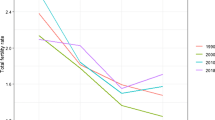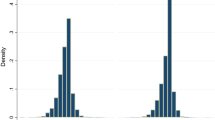Abstract
To examine the relationship between social aspirations, fertility choices and growth performances, we develop a R&D-based model in which individuals care about the number of children they bring up and their social status. In such an economy, we find that stronger status motives have a negative effect on growth. The reason is that individuals bring up fewer children, as children are an obstacle to the achievement of their social status. Introducing an endogenous choice of quality for children, we show that stronger status motives lead individuals to bring up fewer but higher quality children. In this case, social aspirations heighten the desire of parents to substitute the quantity for the quality of children because education of children fosters society’s productive ability, indirectly improving parents’ social status.
Similar content being viewed by others
References
Abel AB (1990) Asset prices under habit formation and catching up with the Joneses. Am Econ Rev 80(2):38–42
Aghion P, Howitt P (1992) A model of growth through creative destruction. Econometrica 60(2):323–351
Alvarez-Cuadrado F, Monteiro FG, Turnovsky S (2004) Habit formation, catching up with the Joneses, and economic growth. J Econ Growth 9(1):47–80
Barro RJ, Becker GS (1988) A reformulation of the economic theory of fertility. Q J Econ 53(1): 1–25
Barro RJ, Becker GS (1989) Fertility choice in a model of economic growth. Econometrica 57(2): 481–501
Barro RJ, Sala-i-Martin X (2004) Economic growth. 2nd edition, MIT, Cambridge
Becker GS (1991) A treatise on the family. Harvard University Press, Cambridge
Becker GS, Murphy KM, Tamura R (1990) Human capital, fertility, and economic growth. J Polit Econ 98(5):S12–S37
Black SE, Juhn C (2000) The rise of female professionals: are women responding to skill demand? Am Econ Rev 90(2):450–455
Boonprakaikawe J, Tournemaine F (2006) Production and consumption of education in a r&d-based growth model. Scott J Polit Econ 53(5):565–585
Clark AE, Oswald AJ (1996) Satisfaction and comparison income. J Polit Econ 61(3):359–381
Corneo G, Jeanne O (1997) On relative wealth effects and the optimality of growth. Econ Lett 54(1):87–92
Doepke M (2004) Accounting for fertility decline during the transition to growth. J Econ Growth 9(3):347–383
Dolado J, Felgueroso F, Jimeno JF (2001) Female employment and occupational changes in the 1990s: how is the EU performing relative to the US? Eur Econ Rev 45(6):875–879
Dolado J, Felgueroso F, Jimeno JF (2002) Reent trnds in occupational segregation by gender: a look across the atlantic. Working paper 02–30, University Carlos III, Madrid
Fershtman C, Murphy KM, Weiss Y (1996) Social status, education and growth. J Polit Econ 104(1):108–132
Futagami K, Shibata A (1998) Keeping one step ahead of the Joneses: status, the distribution of wealth, and long run growth. J Econ Behav Organ 36(1):109–126
Gali J (1994) Keeping up with the Joneses: consumption externalities, portfolio choice, and asset prices. J Money Credit Bank 26(1):1–8
Grossman GM, Helpman E (1991a) Quality ladders in the theory of growth. Rev Econ Stud 58(1):557–586
Grossman GM, Helpman E (1991b) Innovation and growth in the global economy. MIT, Cambridge
Hopkins E, Kornienko T (2004) Running to keep in the same place: consumer choice as a game of status. Am Econ Rev 94(4):1085–1107
Hume D (1978) A treatise of human nature, 2nd edn. In: Selby-Bigge LA, Neddich P (Eds). Clarendon, London
Jones CI (1995) R&D-based models of economic growth. J Polit Econ 105(4):759–784
Jones CI (2002) Source of US economic growth in a world of ideas. Am Econ Rev 92(1):220–239
Jones CI (2003) Population and ideas: a theory of endogenous growth. In: Aghion P, Frydman R, Stiglitz J, Woodford M (eds) Knowledge, information, and expectations in modern macroeconomics, in honor of Edmund S Phelps. Princeton University Press, Princeton, pp 498–521
Jones CI, Williams JC (2000) Too much of a good thing? The economics of investment in R&D. J Econ Growth 5(1):65–85
Kapteyn A, Van de Geer S, Van de Stadt H, Wansbeek T (1997) Interdependent preferences: an econometric analysis. J Appl Econ 12(6):665–686
Long NV, Shimomura K (2004) Relative wealth, status seeking and catching-up. J Econ Behav Organ 53(4):529–542
McBride M (2001) Relative income effects on subjective well-being in the cross-section. J Econ Behav Organ 45(3):251–278
Palivos T (1995) Endogenous fertility, multiple growth paths, and economic convergence. J Econ Dyn Control 19(8):1489–1510
Pham TKC (2005) Economic growth and status-seeking through personal wealth. Eur Z Polit Okon 21(2):407–427
Marx K (1964) Economic and philosophic manuscripts of 1844. Translated by Milligan M, International Publishers, New York
Phelps ES (1968) Population increase. Can J Econ 1(3):497–518
Rauscher M (1997) Conspicuous consumption, economic growth and taxation. J Econom 66(1):35–42
Romer P (1986) Increasing returns and long-run growth. J Polit Econ 94(5):1002–1037
Romer P (1990) Endogenous technological change. J Polit Econ 98(5):S71–S102
Simon JL (1977) The economics of population growth. Princeton University Press, Princeton
Smith A (1759) The theory of moral sentiments? Reprinted, Liberty Fund, Indianapolis, 1982
Tsoukis C (2007) Keeping up with the Joneses, growth, distribution and optimal taxation. Scott J Polit Econ (in press)
Uhlig H, Yanagawa N (1996) Increasing the capital income tax may lead to faster growth. Eur Econ Rev 40(8):1521–1540
Veblen T (1899) The theory of the leisure class. Reprinted, Modern Library, New York, 1934
Zou H (1995) The spirit of capitalism and long run growth. Eur Z Polit Okon 10(2):279–293
Author information
Authors and Affiliations
Corresponding author
Additional information
Responsible editor: Alessandro Cigno
I would like to thank Michael Bleaney, Juntip Boonprakaikawe, Trudy Owens, Kaipichit Ruengsrichaiya, two anonymous referees, and one editor of the review for their helpful comments and suggestions. I am grateful to the University of Nottingham (UK) for its support during the redaction of this paper.
Rights and permissions
About this article
Cite this article
Tournemaine, F. Social aspirations and choice of fertility: why can status motive reduce per-capita growth?. J Popul Econ 21, 49–66 (2008). https://doi.org/10.1007/s00148-006-0133-4
Received:
Accepted:
Published:
Issue Date:
DOI: https://doi.org/10.1007/s00148-006-0133-4




